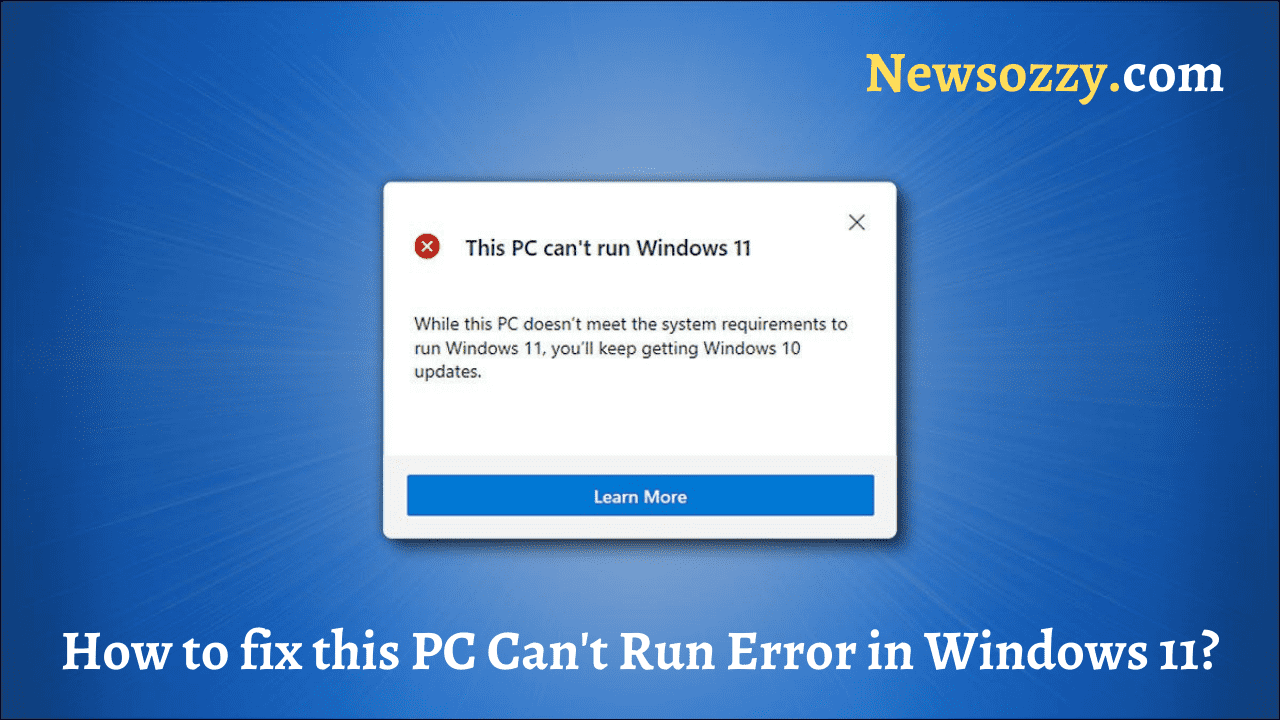News
Fix “This PC can’t run Windows 11” Error | Ways to Bypass/Fix Windows 11 PC Can’t Run Message

Microsoft has released the awaited upgrade for the world’s most used operating system, the Windows 11. Successor to Windows 10, this new upgrade has taken the tech world by storm and has left every reviewer speechless. Windows 11 comes out with a plethora of new features like the new rounded corners making it extremely pleasing to the eyes, providing ease and simplicity to the users.
The brand new upgrade delivers consistent and all-around performance, providing excessive support for the users, with increased creativity and productivity. This new level in the operating system is a response to the increased competition by fellow competitors Google and Apple.
- Basic System Requirements for Windows 11
- How to Fix Error this PC Can’t Run Windows 11?
- Method 1: Enabling Trusted Platform Module 2.0 from BIOS
- Method 2: Enabling the Secure Boot
Basic System Requirements for Windows 11
Microsoft also demands several minimum hardware requirements to install and run the brand new Windows Operating System. They are –
- A 64-bit processor with a clock speed of 1 Gigahertz (GHz) or more.
- Two or more cores (Intel, AMD, or Qualcomm Processors are able to run the new Windows 11)
- 4 Gigabytes (GB) or higher of RAM
- A 64 GB or bigger storage device (Any type would work for the Windows 11, HDD, or the faster SSD)
- A display should have a minimum resolution of 1280 x 720 and a diagonal length larger than 9-inches.
- It is necessary for the system firmware to support UEFI and Secure Boot along with the Trusted Platform Module (TPM) version 2.0
- A compatible Graphics Card with DirectX-12 or higher with a WDDM 2.0 driver.
To make the process simpler and allow users to download an application called PC Health Check application released by Microsoft which helps check whether the PC is compatible with the latest upgrade or not. Unfortunately, the download link for that tool is no longer available officially online, so users would have to opt for pirated versions or instead can install the open-source tools helping do the same.
A lot of users who were able to install and use the Health Check app have received a pop-up message saying “This PC can’t run Windows 11” upon running the Microsoft recommended check. This pop-up message provides further information on why the latest Windows upgrade cannot run on your system, and reasons which were included were – storage space less than required 64GB, the processor does not support the upgrade, most common one – Trusted Platform Module (TPM 2.0) and Secure Boot are disabled or not installed. The Trusted Platform Module (TPM) and Secure Boot problems can easily be resolved. The other issues would require a physical hardware change or upgrade.
See More: How to turn on/off Dark mode in Windows 11?
How to Fix Error this PC Can’t Run Windows 11?
There are different methods by which we can fix this PC can’t run error in windows 11. They are explained in detail below for your reference
Method 1: Enabling Trusted Platform Module 2.0 from BIOS
The Trusted Platform Module or TPM is a security and privacy chip that performs hardware-based security and privacy-related functions on the newer Windows running PCs by storing encryption keys securely. The TPM 2.0 chips contain multiple physical and digital security mechanisms making it difficult for hackers, viruses, and other malicious applications to alter them.
Microsoft decided to make use of TPM 2.0 (The most recent update of the chip, launched and added in every PC post-2016. If the health check-up reports the message regarding uninstalled or disabled TPM, it just means you have to enable it ) mandatory for any Windows device. If your PC is not archaic, it is likely that the privacy chip has already been soldered onto your motherboard, and needs to be enabled.
Another system requirement for running Windows 11 is the TPM 2.0 version and not the previous TPM 1.2 which caught most of the customers by surprise. Microsoft initially had revealed TPM 1.2 as the basic hardware requirement but now has changed it to TPM 2.0 completely restricting a plethora of PCs from downloading and running this new update.
The Trusted Platform Module privacy and security technology can be managed from the Basic Input Output System or BIOS menu, but before we boot it, it is better to ensure if your computer is equipped with the TPM 2.0, which is compatible with Windows 11. Follow these steps –
- Select the Start menu and select the ‘Run’ from the power user menu.
- Type out the text given in the text field and click on the OK button. “tpm.msc”
- You would have to wait for the Trusted Platform Manager (TPM) Management on the local PC application to launch. Check the ‘Status’ and then the ‘Specification Version’. If the ‘Status’ field section reports ‘The TPM is ready for use’ and if your TPM version is 2.0, then the health check appLIcation by Microsoft themselves is at fault.
- Microsoft reported this issue and has taken down the application for the same reason, as they want to work on it and release an improved version without any faults later.
But if the status indicates TPM is disabled or can’t be found on the system, follow the given steps to enable TPM –
- As we had mentioned earlier, the Trusted Platform Manager can be enabled by using the BIOS or the UEFI menu. So we start by shutting down all the active applications, and pressing keys (Alt +F4) when you are on the desktop. It opens up the start menu and you choose to shut down and click on the OK button.
- Next, we restart the system and press the specialized and unique BIOS key to enter the menu. Every manufacturer has created a unique BIOS key and can be found using a quick internet search or by reading the manufacturer-given user manual. Most commonly, the BIOS keys are either F1, F2, F11, or the delete or backspace button.
- When you’ve finally entered the BIOS menu, look for the Security page or security tab (which for most users would be under the advanced settings option) using your keyboard arrow keys.
- The next step would be to locate the ‘TPM settings’. Even though the name would vary from device to device, depending on the manufacturer, it most often goes by that label. For example, for Intel-containing systems, it is named “iPPT” or the “Intel Trusted Platform Technology”, for AMD-equipped devices, it goes by the name “fTPM” or “Firmware Trusted Platform Module”.
- In the TPM settings, switch the TPM Device’s status to ‘Available’ and the TPM State to ‘Enabled’. (It is advised not to interfere with the other TPM-related settings as it might lead to making the task difficult.)
- Click the save button to save your new TPM settings and then restart your PC. Now, you run the Windows 11 health check application again and check if you are able to fix the “This PC can’t run Windows 11” error.
See More: How to fix the WebCam which is not working on Windows 11
Method 2: Enabling the Secure Boot
As the name suggests, Secure Boot is a security feature that allows only the trusted Operating System and software to boot. The standard BIOS or legacy boot will load the boot loader without carrying out any checks. Whereas the modern Unified Extensible Firmware Interface or the UEFI boot tech performs all the possible checks before loading and stores all the Microsoft official certificates.
This helps prevent malware from interfering with the booting process and results in improved overall security. Secure boot is also known for causing issues when you boot specific Linux distributions or different incompatible software. If you want to check whether the computer supports the Secure Boot technology or not,
- type the text given below in the Run Command box (Windows Key + R) and press enter.
“msinfo32”
- Look at the ‘Secure Boot State’ value
- and if it reports ‘Unsupported’, you will not be able to install the new Windows 11 (without other third party means)
- Otherwise, if it reports ‘Off’, follow the given steps.
- Just like the Trusted Platform Module (TPM), you can enable the Secure Boot can by using the BIOS or UEFI menu. You can follow steps 1 or 2 of the previous process to browse the BIOS menu.
- Using the arrow keys, switch to the Boot tab to enable secure boot.
For most of the cases, the Secure Boot enabling option will be available inside the Security or advanced menu. Once the Secure Boot enabling is done, a confirmation request message will appear where you choose to continue by accepting yes.
Note: Ensure the Boot mode is put on to UEFI mode and not Legacy.
3. Make sure to save your modifications and press exit. The error message that said “This PC can’t run Windows 11” won’t appear anymore.
Conclusion
Microsoft is doubling down on the security and privacy requirements via the Trusted Platform Module (TPM) and Secure Boot to run the new Windows 11. Regardless, you need not worry if your current PC does not support or reach the minimum requirements for the new Windows 11, as there are many workarounds to fix the incompatibility issues.
You can rest assured that you will be covered with the desired workarounds along with many other guides regarding Windows 11. Let us know your queries and suggestions in the comment section!
-

 News2 years ago
News2 years agoWhatsApp DP for Students to Free Download | Creative WhatsApp Profile Picture Images that Make you Smile
-

 News2 years ago
News2 years agoTop 100 Funny Group Chat Names for WhatsApp & Other Social Media Apps | Best Cute Cool Fun Ideas for Group Names
-

 News2 years ago
News2 years agoMorning Assembly Word of the Day List for Students | Best Word of the Day for High School Students
-

 News2 years ago
News2 years agoBest Cute Funny Throwback Picture Captions 2022 | Unique Flashback Quotes for Instagram Posts & Stories
-

 News3 years ago
News3 years ago100+ Best Captions for Brother’s Handsome Photo That You Can Copy And Paste Easily
-

 Instagram2 years ago
Instagram2 years agoTop 200+ Best Cute Cool Instagram Bio Ideas of 2022 That You Can Copy-Paste Easily
-

 News2 years ago
News2 years ago100+ Best Cute Sweet Funny Instagram Captions for Sisters Photo | Get Free IG Quotes & Puns for Sisters Selfies
-

 News2 years ago
News2 years agoWhat are Some Cool Funny Activities for College Students? | Best Tasks for Party Games






